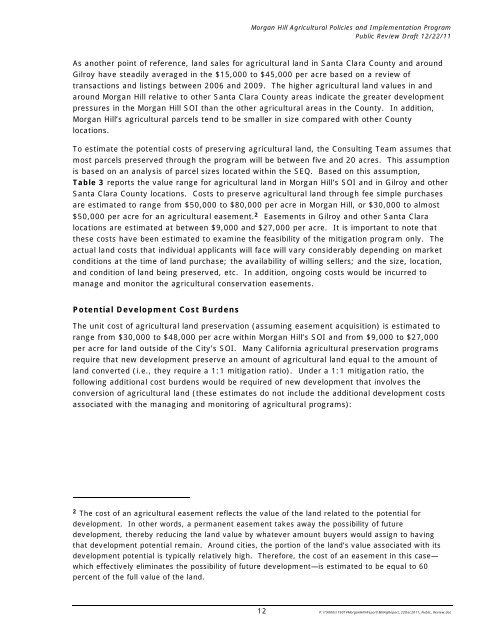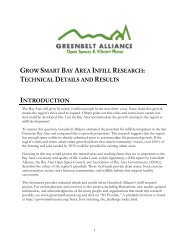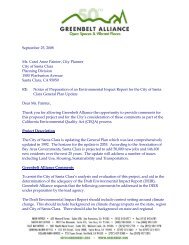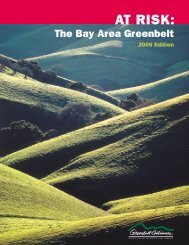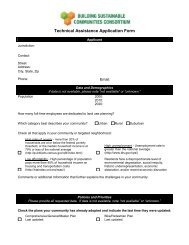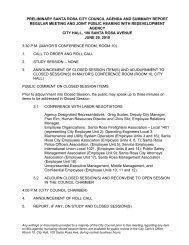Morgan Hill Agricultural Policies and Implementation Program
Morgan Hill Agricultural Policies and Implementation Program
Morgan Hill Agricultural Policies and Implementation Program
You also want an ePaper? Increase the reach of your titles
YUMPU automatically turns print PDFs into web optimized ePapers that Google loves.
<strong>Morgan</strong> <strong>Hill</strong> <strong>Agricultural</strong> <strong>Policies</strong> <strong>and</strong> <strong>Implementation</strong> <strong>Program</strong><br />
Public Review Draft 12/22/11<br />
As another point of reference, l<strong>and</strong> sales for agricultural l<strong>and</strong> in Santa Clara County <strong>and</strong> around<br />
Gilroy have steadily averaged in the $15,000 to $45,000 per acre based on a review of<br />
transactions <strong>and</strong> listings between 2006 <strong>and</strong> 2009. The higher agricultural l<strong>and</strong> values in <strong>and</strong><br />
around <strong>Morgan</strong> <strong>Hill</strong> relative to other Santa Clara County areas indicate the greater development<br />
pressures in the <strong>Morgan</strong> <strong>Hill</strong> SOI than the other agricultural areas in the County. In addition,<br />
<strong>Morgan</strong> <strong>Hill</strong>’s agricultural parcels tend to be smaller in size compared with other County<br />
locations.<br />
To estimate the potential costs of preserving agricultural l<strong>and</strong>, the Consulting Team assumes that<br />
most parcels preserved through the program will be between five <strong>and</strong> 20 acres. This assumption<br />
is based on an analysis of parcel sizes located within the SEQ. Based on this assumption,<br />
Table 3 reports the value range for agricultural l<strong>and</strong> in <strong>Morgan</strong> <strong>Hill</strong>’s SOI <strong>and</strong> in Gilroy <strong>and</strong> other<br />
Santa Clara County locations. Costs to preserve agricultural l<strong>and</strong> through fee simple purchases<br />
are estimated to range from $50,000 to $80,000 per acre in <strong>Morgan</strong> <strong>Hill</strong>, or $30,000 to almost<br />
$50,000 per acre for an agricultural easement. 2 Easements in Gilroy <strong>and</strong> other Santa Clara<br />
locations are estimated at between $9,000 <strong>and</strong> $27,000 per acre. It is important to note that<br />
these costs have been estimated to examine the feasibility of the mitigation program only. The<br />
actual l<strong>and</strong> costs that individual applicants will face will vary considerably depending on market<br />
conditions at the time of l<strong>and</strong> purchase; the availability of willing sellers; <strong>and</strong> the size, location,<br />
<strong>and</strong> condition of l<strong>and</strong> being preserved, etc. In addition, ongoing costs would be incurred to<br />
manage <strong>and</strong> monitor the agricultural conservation easements.<br />
Potential Development Cost Burdens<br />
The unit cost of agricultural l<strong>and</strong> preservation (assuming easement acquisition) is estimated to<br />
range from $30,000 to $48,000 per acre within <strong>Morgan</strong> <strong>Hill</strong>’s SOI <strong>and</strong> from $9,000 to $27,000<br />
per acre for l<strong>and</strong> outside of the City’s SOI. Many California agricultural preservation programs<br />
require that new development preserve an amount of agricultural l<strong>and</strong> equal to the amount of<br />
l<strong>and</strong> converted (i.e., they require a 1:1 mitigation ratio). Under a 1:1 mitigation ratio, the<br />
following additional cost burdens would be required of new development that involves the<br />
conversion of agricultural l<strong>and</strong> (these estimates do not include the additional development costs<br />
associated with the managing <strong>and</strong> monitoring of agricultural programs):<br />
2 The cost of an agricultural easement reflects the value of the l<strong>and</strong> related to the potential for<br />
development. In other words, a permanent easement takes away the possibility of future<br />
development, thereby reducing the l<strong>and</strong> value by whatever amount buyers would assign to having<br />
that development potential remain. Around cities, the portion of the l<strong>and</strong>’s value associated with its<br />
development potential is typically relatively high. Therefore, the cost of an easement in this case—<br />
which effectively eliminates the possibility of future development—is estimated to be equal to 60<br />
percent of the full value of the l<strong>and</strong>.<br />
12 P:\19000s\19014<strong>Morgan</strong><strong>Hill</strong>\Report\MHAgReport_22Dec2011_Public_Review.doc


